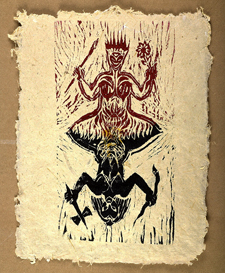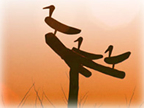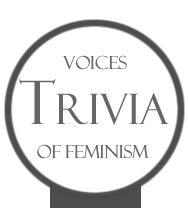Editorial
Lise Weil
Over the course of the past few months, and despite our turning away lots of worthy material, this issue has ballooned out beyond its projected size to become larger than the double issue we published last fall.1 It appears that many women, in this moment of history, are thinking about goddesses. And the thinking they are doing, as you will see, is extraordinarily rich and diverse. A canoe trip in New England opens out suddenly into the sacred terrain of the Taíno goddesses of the Dominican Republic; a trip to Kerala India to study menarche rites leads to a profound appreciation of everyday objects; Inanna’s appearance in a dream shapes the course of a life and literary career; a dream helps a young wife and mother escape the influence of the Roman Catholic and Black Methodist Church and find her way to the Yoruban goddesses; a devoted midwife finds goddess in birthgiving and comes to see women’s bodies as “portals of the divine.” In most of the articles collected here, the scholarly is seamlessly woven with the intensely personal; rigorous thought and deep emotion are indissoluble. To orient oneself to goddess, both the essays and the poetry suggest, is to liberate oneself from oppressive strictures, to learn from rivers and mountains, to listen attentively to birds, to revel in female sensuality, to honor pots and bowls and candles, to celebrate community, to live more consciously and joyfully.
For those who dismiss goddess talk as irrelevant to today’s world, consider the role the goddess has played in U.S., and world, affairs. Had Hawaii’s Queen Liliuokalani listened to her shaman advisors and followed the instructions of the goddess Hiiaka, Carolyn Gage tells us, she would probably have been restored to the throne and Hawaii would have retained its sovereignty. The Japanese sun goddess Amaterasu, we learn from Shannyn Sollitt, was a bargaining chip in the U.S. negotiations with Japan that led to the bombing of Hiroshima and Nagasaki. And who knew, as Katya Miller informs us, that for 140 years the U.S. has had its very own presiding goddess, one with indigenous and matrilineal roots, in Lady Freedom, the statue that sits atop the Capitol Dome?
Goddesses are not only about peace and light, as some of the writers here remind us. Lilith,  Eve’s precursor, is a night demoness, wild and insubordinate; la Ciguapa, the Taíno trickster goddess, radiates cunning and wild energy. “I think we have much to learn from the infinite wisdom of the oldest images of the great mothers, who contained light and darkness, creation and destruction, yin and yang,” writes Luciana Percovich. In Deena Metzger’s “Vulture Medicine,” we find those great mothers and their wisdom still with us today in the animal realm: “She is not poisoned by the dead;/What we must not eat,/she eats for our sake/ But she is poisoned by our poisons ...” Just now, on the cusp of an era in which we stand to witness both destruction and creation in unprecedented measure, it has never seemed more urgent that we pay attention to the bearers of such wisdom, to those creatures who know something about the composting of poison into medicine.
Eve’s precursor, is a night demoness, wild and insubordinate; la Ciguapa, the Taíno trickster goddess, radiates cunning and wild energy. “I think we have much to learn from the infinite wisdom of the oldest images of the great mothers, who contained light and darkness, creation and destruction, yin and yang,” writes Luciana Percovich. In Deena Metzger’s “Vulture Medicine,” we find those great mothers and their wisdom still with us today in the animal realm: “She is not poisoned by the dead;/What we must not eat,/she eats for our sake/ But she is poisoned by our poisons ...” Just now, on the cusp of an era in which we stand to witness both destruction and creation in unprecedented measure, it has never seemed more urgent that we pay attention to the bearers of such wisdom, to those creatures who know something about the composting of poison into medicine.
I was delighted last month to discover that Trivia, that triple goddess after whom this journal is named, was herself associated with composting. In a letter to me, Deena Metzger mentioned that “Tri Via was the meeting of the three roads where Hekate (as the triple goddess) presided and received the offering of garbage, emphasizing the sacred aspect of birth life and death – compost and its renewal.” If this is so, and Deena assures me it is, though she is unable to recall the original source for this information—how wonderful to know the very name of this journal gestures towards that life/death/rebirth wisdom we are all so in need of at this time.
In my doctoral thesis, completed some twenty years ago, I wrote about the novels of Virginia Woolf and German writer Christa Wolf, novels which seemed to me related by deep and unconscious correspondences. In Between the Acts, Woolf’s last novel, written as the bombs of WWII fell on London, I found striking parallels to Wolf’s Cassandra, published in 1983 but set during the time of the Trojan War. Both of them depict a civilization on the verge of utter collapse; both are shot through by an understanding of the grim futility of patriarchal thought and action. At the very same time, both novels are an attempt to invoke divine female presence and restore powers that have been lost to us. In Between the Acts, the features of Isis, the Egyptian creation goddess, are distributed among the three female protagonists, who together bring a hope of renewal to the deadly repetitions, both amorous and political, being played out in the novel’s foreground. In Cassandra, as Troy comes under siege by the Greeks and increasingly succumbs to wartime values—hero worship, bombast, contempt for women—Cassandra joins a group of women who have settled down in caves outside the city limits, where they dance, worship the goddess Cybele, and celebrate life: “The seasons. The scent of the trees. And our free existence, a new joy for each new day … The citadel did not reach as far as here."2 In this moment of history, as the global economy teeters on the edge of collapse and we hover, as a species, on the brink of multiple tipping-points, I think often of these two amazingly prescient novels and their faith in the resurgence of that world of powerful female presence and vision. I think of their shared insight that the very extremity of a historical crisis can itself be fertile soil for the generation of a livable alternative.
It may seem odd to be pointing to a resurgence of ancient female wisdom and power at a time when all around the globe heads are turning expectantly to the man the U.S. has just elected to its highest office. Yet consider the fact that this man visibly adores his wife and his daughters, was raised by women, and has written of his mother “what is best in me I owe to her.” If Obama offers hope of genuine renewal and healing, maybe it’s because, certainly more than any other world leader in recent memory, he is a bearer of that supreme goddess wisdom Sollitt gleans from the story of Amaterasu: “the feminine spirit and soul, the warp and the weft of life on this precious planet, is the light of the whole world.”
- I want to thank Hye Sook Hwang, who took time out from her own important and exciting goddess scholarship to help assemble the articles in this issue.
- Christa Wolf, Cassandra: A Novel and Four Essays,tr. Jan van Heurck. New York: Farrar, Strauss, Giroux, 1984, p. 132.
Hye Sook Hwang
After reading many submissions for this issue, I exclaimed to Lise electronically:
"What I am realizing through the process of being co-editor on this Goddess issue is that the topic of Goddess creates a response which is amorphous and yet contagious. I myself do not know what the norm of writing or even thinking about Goddess is for an issue like this one. It is very personal, steeped in the takes or rejects of very common motifs like nature, nationalist symbol of the freedom statue, Native Indian and Afro-American perspectives, all too rich and complex to make a judgment which one is more important to us. My thinking cannot catch up with all those intricate workings of images, events, and thoughts."
The crisscrossing of topics and perspectives patterned in the essays has enchanted me. The voice that shapes these patterns in each piece has allowed me to see the working of Goddess within the female self. I swell with the creativity, sensitivity, and commitment embodied in this issue.
It is my honor and privilege to co-edit the present issue dedicated to Goddess with Lise Weil, whose zeal and commitment to the editorial work I admire and appreciate dearly. Thanks to her understanding of my ridiculously overwhelming schedule during the past six months, I am still here to write an editorial. I thank Harriet Ellenberger who has supported me to go forward with this work. I appreciate Susan Kullmann for her wonderful work of web-designing and publishing this issue as well as her previous work for my piece in Trivia #6.
“Goddess” is a word that is problematic and yet necessary for lack of a better word. It is problematic because it is linguistically derivative of “god.” The term “goddess” therefore fails to convey the original and encompassing nature of the Female, she-reality. Equally problematic are “female” and “she” because they too are linguistically indicative of “male” and “he.” In short, the language we use works against the notion that we seek to convey. Languages have been hijacked by patriarchal builders and the original sex/gender principle associated with pro/creation has been taken hostage. Or so I thought. Quite pessimistic, I would say now. I now suggest that we transform the language by stipulating a new meaning for the word “goddess”: a norm from which “god” is not only derived but in which it is included. Likewise, by calling Her “Female,” we mean that the male is derived from and included in Fe/male, as is he in s/he. She is the Origin, the Creatrix, from whom both he and she are derived and in which they are included. The Fe/male principle is asymmetrical with the male principle. “She” antecedes and embodies “he.” “He” is an extending and often distorted reflection of “She.” Wo/man is a human norm from which man originates. Only with such a semantic device is it possible for us to discuss Goddess. How else can I present Mago, the Goddess I know from East Asia, who is the Origin, the Way, and the Heaven? The term “Mago” means the Great Goddess. Sex/gender dualism is deemphasized in the tradition of Mago that I call Magoism. In fact, the triadic principle of Mago Samsin (Triad Deity) overrides the dualistic scheme of yin/yang. The Fe/male Triad is the creative mechanism devised by the ancients to cope with dualistic reductionism. I am pleased to see my understanding of Goddess has proven to be real and effective in a variety of ways expressed in these essays. The cross-cultural working of Goddess is evident. (As a Korea-born fe/male, my presence in the West is cross-cultural by default.)
How else can I present Mago, the Goddess I know from East Asia, who is the Origin, the Way, and the Heaven? The term “Mago” means the Great Goddess. Sex/gender dualism is deemphasized in the tradition of Mago that I call Magoism. In fact, the triadic principle of Mago Samsin (Triad Deity) overrides the dualistic scheme of yin/yang. The Fe/male Triad is the creative mechanism devised by the ancients to cope with dualistic reductionism. I am pleased to see my understanding of Goddess has proven to be real and effective in a variety of ways expressed in these essays. The cross-cultural working of Goddess is evident. (As a Korea-born fe/male, my presence in the West is cross-cultural by default.)
The earliest solicitation of the essays partially included in this issue came about after the 2008 conference of the American Academy of Religion in the Western Region (AAR/WR) held in Pasadena, CA. (I with the support of others have convened at least two special sessions in this conference under the rubric of Goddess Studies. We have formed a planning committee for this task.) We held a pre-conference workshop and two sessions of “Goddess Studies” last year and will be holding a third this year. Out of “Pure Lust,” to borrow Mary Daly’s words, it was a natural next step for us to encourage the participants to redesign their papers into more personal narratives so that their scholarship could reflect women’s experiences as well. Then, I asked Trivia about the possibility of publication.
To convene sessions in the name of Goddess Studies was no small fruition given that a female scholar’s work on Goddess is still taken lightly in mainstream academia. Women scholars whose research is primarily grounded in Goddess face a dead end in their pursuit of an academic career. This I have experienced. Thus, the very visualization of “Goddess Studies” in this conference, regional and colloquial, was not only a symbolic act. It was an act of realization; some of us combined our efforts to materialize our Goddess work in the form of an academic conference. The initial momentum was given in 2007 when we, out of necessity and desperation, called for a spontaneous and informal meeting among women scholars of the female divine during the conference of AAR/WR in Berkeley, CA. Nane Jordan, who was enthusiastic about the idea of these scholars getting together, has joined me in this project of publishing our essays in Trivia. Jordan, whose academic inquiry stems from her midwifery career, as inspirationally told in this issue, recalls our initial meeting as follows:
“We sat around this table and shared about our work and what we saw as the challenges of doing Goddess scholarship in the academy. So many themes emerged: the sense of isolation experienced by those working outside of the San Francisco Bay area, outside of one of the women’s spirituality graduate degree programs, coupled with difficulties of entering the academic and religious studies “job market” when pursuing Goddess scholarship. There were stories of how pursuing Goddess-based scholarship can still be anathema to a paid scholarly path. We talked of the pivotal role of independent scholars in forging this field, due to its emergence from within feminist and non-institutionalized agendas. Thus, finding one’s ‘place’ in this work calls us from heart-felt passion, as a path with no definitive ends. There was desire voiced to be mindful of representing the Goddess field from non-Eurocentric views, sharing our experiences and working to build multiple locations in which our work can be represented. Also, there was the question of what this term ‘Goddess’ really means – does it fit the work we are all doing?”
I am delighted to be reconnected with Luciana Percovich, Judy Grahn, and Betty Meador, whose essays are included in this issue. I thank Dianne Jenett and Annie Lapham for their cherished interest in and support for this issue. I owe my thanks to Patricia Monaghan, Miranda Shaw, and Laura Truxler who enriched this circle of Goddess Scholars in the Western Region; I thank Patricia and Miranda who flew from the mid-west and east to join the conference in 2008. Laura Truxler has shown us her unflagging support by being an active member of the planning committee. I extend my thanks also to Marguerite Rigoglioso, Arisika Razak, Max Dashu, Susan Carter, Louise Pare, Mara Keller, Inhui Lee, Kahena Viale, and others whose names I cannot list here.
Please note that we are seeking a guest editor—or editors—for issue #11, scheduled to appear in March 2010.
The theme can be of your choosing. Required: resonance with Trivia’s mission and significant editorial experience. Send queries directly to the editor:
Join our Trivia - Voices of Feminism group on Facebook

